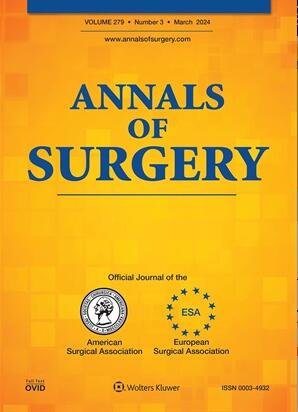肝脏移植中的顺序外分配:改善器官利用率的拙劣工具。
IF 7.5
1区 医学
Q1 SURGERY
引用次数: 0
摘要
我们评估了OOS对器官利用的影响,以及哪些因素影响了采用OOS的决定。背景:已故供体肝脏的分配通常遵循潜在受体的分级匹配运行。器官采购组织(opo)可能会使用“无序”(OOS)配型偏离肝移植标准化分配。方法对来自移植受者科学登记处(SRTR)(2013年1月1日- 2023年8月31日)的所有符合条件的供体进行鉴定,并将其与潜在移植受者(PTR)数据中的相关配型进行合并。OOS报价定义为旁路代码(861-863;760 - 765)。在opo中嵌套的符合条件的献血者的分层混合效应模型评估了oos实践与器官利用,通过风险五分位数、血型和年份的丢弃风险指数(DSRI)控制肝移植风险。结果oos的发生率逐年增加。TC的oos率(R2<0.01)和OPO的oos率(R2<0.01)与利用率的增加无关。OOS与提高利用率无关(OR=1.11, 95%CI=0.90-1.38)。DBD&DCD移植风险的增加与利用率的降低有关。引入oos分配交互术语提高了所有风险级别的DCD的利用率,但仅提高了dssi第5 -五分位DBD的利用率。38%的利用率是由移植物因素引起的,而5%的利用率是由TC和opo变异引起的(条件r2 =0.431,边际r2 =0.380)。DSRI第3 -5五分位数的高风险DCD移植物不太可能通过OOS分配,尽管这种方法提高了这些移植物的利用率。只有15%的oos分配变异是由移植因子引起的,而23%是由tc和opo变异引起的(条件R2=0.388,边际R2=0.154)。结论soos提高了高危移植物的使用,但移植物风险与实际使用不相关。这突出了OOS中的实用性,但也表明这种做法目前使用不正确。本文章由计算机程序翻译,如有差异,请以英文原文为准。
Out of Sequence Allocation in Liver Transplantation: A Poorly Used Tool to Improve Organ Utilization.
SIGNIFICANCE
We evaluated the impact of OOS on organ utilization and also what factors impact the decision to employ OOS.
BACKGROUND
Deceased donor liver allocation typically follows a ranked match-run of potential recipients. Organ procurement organizations (OPOs) may deviate from liver transplant standardized allocation using "out-of-sequence" (OOS) matches.
METHODS
All eligible donors from the Scientific Registry of Transplant Recipients (SRTR) (1/1/2013-8/31/2023) were identified and merged with associated match-runs in the Potential Transplant Recipient (PTR) data. OOS offers were defined as bypass codes (861-863; 760-765). Hierarchical mixed-effects models with eligible donors nested in OPOs assessed OOS-practices versus organ utilization, controlling for liver graft risk with the Discard Risk Index (DSRI) by risk quintile, blood type, and year.
RESULTS
OOS were more common each progressive year. Neither TC's (R2<0.01) nor OPO's (R2<0.01) OOS-rate correlated with increased utilization. OOS was not associated with improved utilization (OR=1.11, 95%CI=0.90-1.38). Increasing graft risk in DBD&DCD grafts was associated with reduced utilization. Introducing OOS-allocation interaction terms improved utilization for DCD's of all risk levels but only improved utilization for DSRI 5th-Quintile DBD's. 38% of utilization was explained by graft factors versus 5% by TC-&OPO-variability (Conditional-R2=0.431, Marginal-R2=0.380). High-risk DCD grafts in DSRI 3rd-5th-Quintiles were not more likely to be allocated through OOS despite these grafts demonstrating improved utilization with this approach. Only 15% of variation in OOS-allocation was explained by graft factors versus 23% by TC-and OPO-variability (Conditional R2=0.388, Marginal R2=0.154).
CONCLUSIONS
OOS improves utilization in high-risk grafts, but graft risk is not correlated with their actual use. This highlights utility in OOS, but also that this practice is currently incorrectly used.
求助全文
通过发布文献求助,成功后即可免费获取论文全文。
去求助
来源期刊

Annals of surgery
医学-外科
CiteScore
14.40
自引率
4.40%
发文量
687
审稿时长
4 months
期刊介绍:
The Annals of Surgery is a renowned surgery journal, recognized globally for its extensive scholarly references. It serves as a valuable resource for the international medical community by disseminating knowledge regarding important developments in surgical science and practice. Surgeons regularly turn to the Annals of Surgery to stay updated on innovative practices and techniques. The journal also offers special editorial features such as "Advances in Surgical Technique," offering timely coverage of ongoing clinical issues. Additionally, the journal publishes monthly review articles that address the latest concerns in surgical practice.
 求助内容:
求助内容: 应助结果提醒方式:
应助结果提醒方式:


